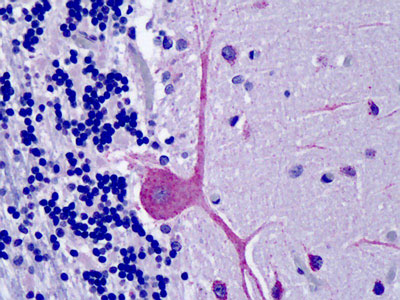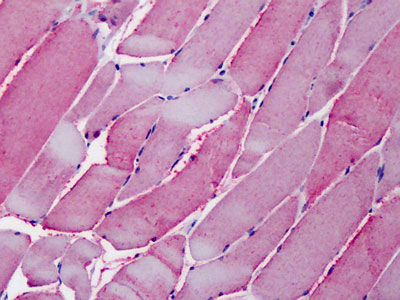OSBPL1A / ORP1 Antibody (C-Terminus)
Goat Polyclonal Antibody
- SPECIFICATION
- CITATIONS
- PROTOCOLS
- BACKGROUND

Application
| WB, IHC-P, E |
|---|---|
| Primary Accession | Q9BXW6 |
| Reactivity | Human, Mouse, Rat, Monkey, Pig, Chicken, Horse, Bovine, Dog |
| Host | Goat |
| Clonality | Polyclonal |
| Calculated MW | 108kDa |
| Dilution | ELISA (1:16000), IHC-P (5 µg/ml), WB (0.5-2 µg/ml) |
| Gene ID | 114876 |
|---|---|
| Other Names | Oxysterol-binding protein-related protein 1, ORP-1, OSBP-related protein 1, OSBPL1A, ORP1, OSBP8, OSBPL1, OSBPL1B |
| Target/Specificity | Human OSBPL1A / ORP1. This antibody is expected to recognise both reported human isoforms of this protein. |
| Reconstitution & Storage | Store at -20°C. Minimize freezing and thawing. |
| Precautions | OSBPL1A / ORP1 Antibody (C-Terminus) is for research use only and not for use in diagnostic or therapeutic procedures. |
| Name | OSBPL1A (HGNC:16398) |
|---|---|
| Function | Binds phospholipids; exhibits strong binding to phosphatidic acid and weak binding to phosphatidylinositol 3-phosphate (By similarity). Stabilizes GTP-bound RAB7A on late endosomes/lysosomes and alters functional properties of late endocytic compartments via its interaction with RAB7A (PubMed:16176980). Binds 25-hydroxycholesterol and cholesterol (PubMed:17428193). |
| Cellular Location | Late endosome. Note=Colocalizes with RAB7A, RAB9A and LAMP1 in late endosomes |

Thousands of laboratories across the world have published research that depended on the performance of antibodies from Abcepta to advance their research. Check out links to articles that cite our products in major peer-reviewed journals, organized by research category.
info@abcepta.com, and receive a free "I Love Antibodies" mug.
Provided below are standard protocols that you may find useful for product applications.
Background
Binds phospholipids; exhibits strong binding to phosphatidic acid and weak binding to phosphatidylinositol 3- phosphate (By similarity). Stabilizes GTP-bound RAB7A on late endosomes/lysosomes and alters functional properties of late endocytic compartments via its interaction with RAB7A.
References
Jaworski C.J.,et al.Genomics 78:185-196(2001).
Xu Y.,et al.J. Biol. Chem. 276:18407-18414(2001).
Lehto M.,et al.J. Lipid Res. 42:1203-1213(2001).
Ota T.,et al.Nat. Genet. 36:40-45(2004).
Nusbaum C.,et al.Nature 437:551-555(2005).
If you have used an Abcepta product and would like to share how it has performed, please click on the "Submit Review" button and provide the requested information. Our staff will examine and post your review and contact you if needed.
If you have any additional inquiries please email technical services at tech@abcepta.com.













 Foundational characteristics of cancer include proliferation, angiogenesis, migration, evasion of apoptosis, and cellular immortality. Find key markers for these cellular processes and antibodies to detect them.
Foundational characteristics of cancer include proliferation, angiogenesis, migration, evasion of apoptosis, and cellular immortality. Find key markers for these cellular processes and antibodies to detect them. The SUMOplot™ Analysis Program predicts and scores sumoylation sites in your protein. SUMOylation is a post-translational modification involved in various cellular processes, such as nuclear-cytosolic transport, transcriptional regulation, apoptosis, protein stability, response to stress, and progression through the cell cycle.
The SUMOplot™ Analysis Program predicts and scores sumoylation sites in your protein. SUMOylation is a post-translational modification involved in various cellular processes, such as nuclear-cytosolic transport, transcriptional regulation, apoptosis, protein stability, response to stress, and progression through the cell cycle. The Autophagy Receptor Motif Plotter predicts and scores autophagy receptor binding sites in your protein. Identifying proteins connected to this pathway is critical to understanding the role of autophagy in physiological as well as pathological processes such as development, differentiation, neurodegenerative diseases, stress, infection, and cancer.
The Autophagy Receptor Motif Plotter predicts and scores autophagy receptor binding sites in your protein. Identifying proteins connected to this pathway is critical to understanding the role of autophagy in physiological as well as pathological processes such as development, differentiation, neurodegenerative diseases, stress, infection, and cancer.



